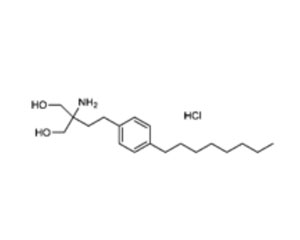FTY-720 HCl/Fingolimod hydrochloride, Purified Small Molecule
Only %1 left
Catalog Number
PE-1854
Discontinued
- Product Name FTY-720 HCl/Fingolimod hydrochloride, Purified Small Molecule
- Product Description Fingolimod (FTY720) is a sphingosine 1-phosphate receptor modulator indicated and approved for the treatment of relapsing-remitting multiple sclerosis. Fingolimod (trade name Gilenya, Novartis) is metabolized by sphingosine kinase to the active metabolite, fingolimod-phosphate. Fingolimod-phosphate is a sphingosine 1-phosphate receptor modulator, and binds with high affinity to sphingosine 1-phosphate receptors 1, 3, 4, and 5. Fingolimod-phosphate blocks the capacity of lymphocytes to egress from lymph nodes, reducing the number of lymphocytes in peripheral blood. The mechanism by which fingolimod exerts therapeutic effects in multiple sclerosis is unknown, but may involve reduction of lymphocyte migration into the central nervous system. Fingolimod was approved as a first-in-class, orally active drug for relapsing multiple sclerosis in 2010, and its applications in other disease conditions are currently under clinical trials.
- Alternative Names Fingolimod Hydrochloride; CAS # 162359-56-0; FTY720; Fingolimod HCl; Gilenia; Gilenya; Fty 720
- Application(s) Neutralize
- Purity Description >98% (HPLC); NMR (Conforms)
- Purity % > 98%
- Regulatory Status For research use only.
Product Info
- Product Description Fingolimod (FTY720) is a sphingosine 1-phosphate receptor modulator indicated and approved for the treatment of relapsing-remitting multiple sclerosis. Fingolimod (trade name Gilenya, Novartis) is metabolized by sphingosine kinase to the active metabolite, fingolimod-phosphate. Fingolimod-phosphate is a sphingosine 1-phosphate receptor modulator, and binds with high affinity to sphingosine 1-phosphate receptors 1, 3, 4, and 5. Fingolimod-phosphate blocks the capacity of lymphocytes to egress from lymph nodes, reducing the number of lymphocytes in peripheral blood. The mechanism by which fingolimod exerts therapeutic effects in multiple sclerosis is unknown, but may involve reduction of lymphocyte migration into the central nervous system. Fingolimod was approved as a first-in-class, orally active drug for relapsing multiple sclerosis in 2010, and its applications in other disease conditions are currently under clinical trials.
- Application(s) Neutralize
- Application Details Fingolimod (FTY720) HCl is a S1P antagonist with IC50 of 0.033 nM in K562, and NK cells.
- Target FTY-720 HCl/Fingolimod hydrochloride
- Target Host Species Species Independent
- Purity Description >98% (HPLC); NMR (Conforms)
- Purity % > 98%
- Format Dry powder; Off-white powder
- Reconstitution Instructions Soluble in DMSO. May be dissolved in DMSO up to 100 mg/mL, or ethanol up to 40 mg/mL
- Storage Instructions Store desiccated as supplied at -20°C for up to 2 years. Store solutions at -20°C for up to 1 month. Prevent multiple freeze-thaw cycles.
- Batch Number Please see item label.
- Expiration Date See storage conditions.
- Alternative Names Fingolimod Hydrochloride; CAS # 162359-56-0; FTY720; Fingolimod HCl; Gilenia; Gilenya; Fty 720
- Scientific Background Pharmacology: An analog of sphingosine which, when taken up into cells, is phosphorylated and acts as an agonist at sphingosine-1-phosphate receptors (S1P1/3) (1). Potently inhibits regulatory T cell proliferation in vitro and in vivo (2). Enhances microvascular remodeling via expansion of arterioles and capillary networks (3). Potent immunomodulator (4). Clinically effective agent for relapsing forms of multiple sclerosis (5). PubChem CID:107969; Product is sold for research use only. Not for human therapeutic use or for medicinal purposes.
- Shipping Temperature 25°C (ambient)
- UNSPSC CODE 12352401
- Regulatory Status For research use only.
Specifications
-
General References
V Brinkmann et al. J. Biol. Chem. 2002 277:21453
AM Wolf et al. J. Immunol. 2009 183:3751
AO Awojoodu et al. Proc. Natl. Acad. Sci. USA 2013 110:13785
K Chiba Pharmacol. Ther. 2005 108:308
T Ziemssen et al. J. Neurol. 2016 263:1053

 1800 605-5127
1800 605-5127 +61 (0)8 8352 7711
+61 (0)8 8352 7711

